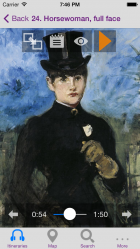
Although Carpaccio was an Italian Renaissance painter of the early 16th century Venetian School, his style was similar to that of the preceding century, due to the painstaking detail of his plants and animals, which was a typical feature of Medieval painting.
This work is considered to be the first European full-length portrait. Against a fictional landscape, the painter has highlighted the figure of an unidentified young man. It is assumed that he wished to portray the prototype of the Christian Knight, adorned with all the virtues that were expected of one who aspired to that status. We can see a white iris and a stoat, both of which are symbols of purity. Next to the stoat is a sign bearing a Latin inscription which translates as: “better dead than stained”, which refers to a stain on one’s honour. There is also a tiger lily, which stands for distinction, an oak for strength, a falcon for courage, and dogs, which allude to faithfulness and loyalty. In amongst these symbols of knightly virtues are the symbols of Evil that are to be defeated. For instance, the frogs which are next to the stoat are a symbol of lust.
There is a scrupulous attention to detail, to be seen in the metallic sheen of the armour, which is beautifully painted. In the background, the same knight can be seen on horseback, elegantly dressed for a tournament.
(c) (R) 2013, MUSMon com S.L.
Text (a) Catalina Serrano Romero
Picture
Source: Wikimedia Commons
Author: File Upload Bot (Eloquence)
Permission: The work of art depicted in this image and the reproduction thereof are in the public domain worldwide. The reproduction is part of a collection of reproductions compiled by The Yorck Project. The compilation copyright is held by Zenodot Verlagsgesellschaft mbH and licensed under the GNU Free Documentation License
Independently produced by MUSMon.com, the audio guide for the Thyssen-Bornemisza Museum offers you a wide-ranging, light-hearted and educational tour of one of Spain’s most outstanding art museums. It contains 90 minutes of commentary, illustrated with over 52 high-quality images, so you won’t miss a single detail during your visit.
We will guide you on your journey through the history of painting. +info




































































